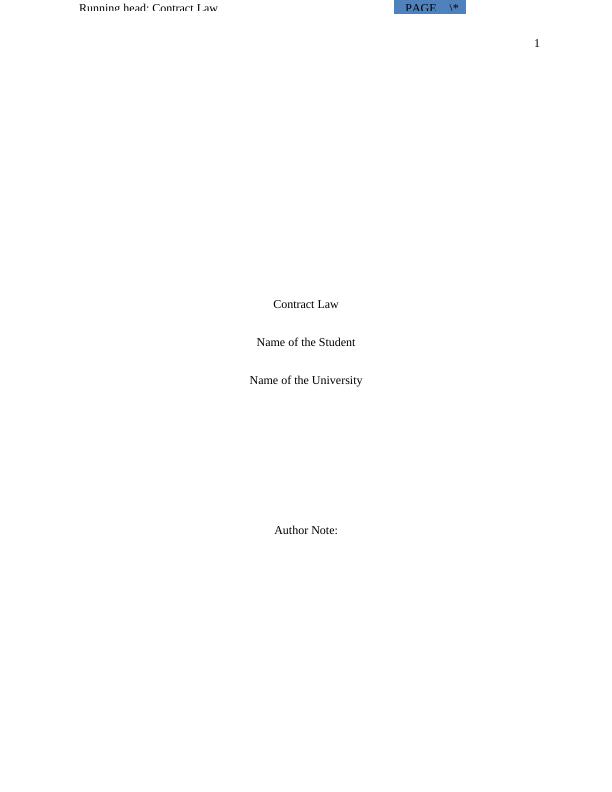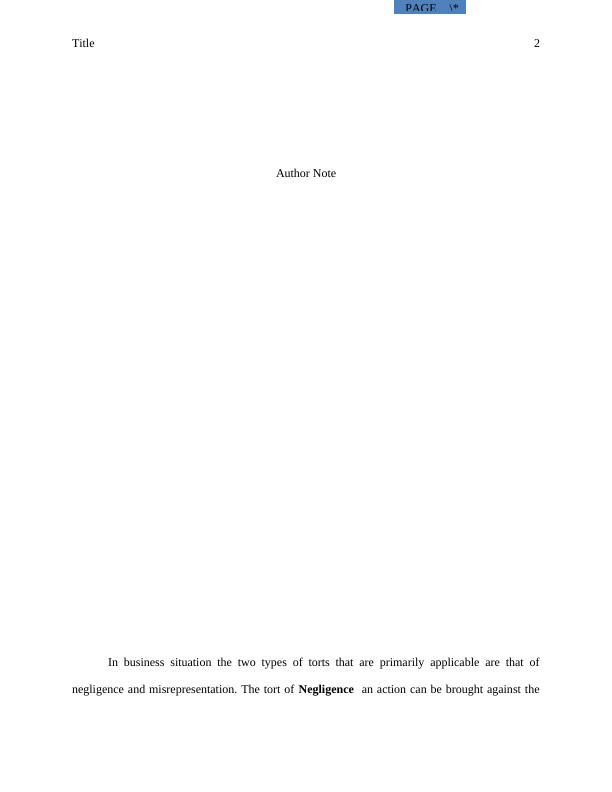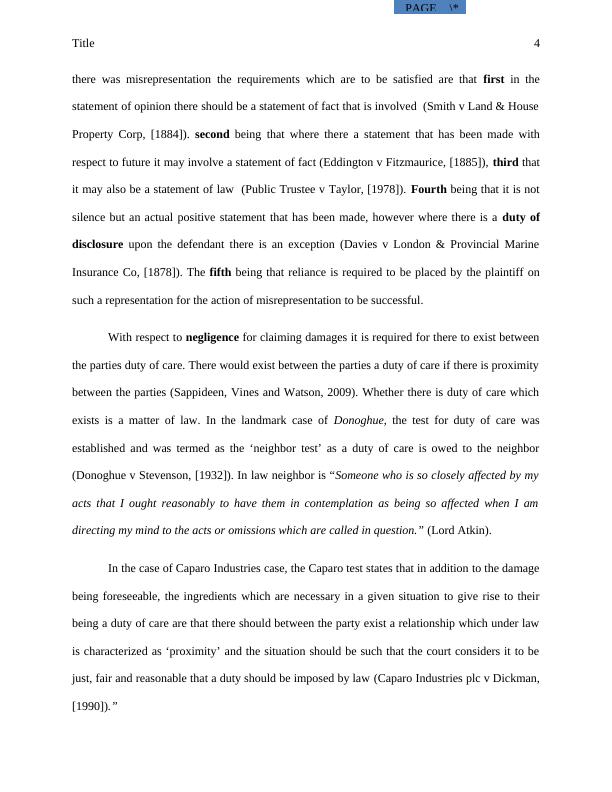Ask a question from expert
Contract Law | Assignment (Doc)
11 Pages2727 Words158 Views
Added on 2020-03-28
Contract Law | Assignment (Doc)
Added on 2020-03-28
BookmarkShareRelated Documents
PAGE \*Running head: Contract Law1Contract LawName of the StudentName of the UniversityAuthor Note:

PAGE \*Title2Author NoteIn business situation the two types of torts that are primarily applicable are that ofnegligence and misrepresentation. The tort of Negligence an action can be brought against the

PAGE \*Title3wrongdoer in the situation where there was a duty of care that was owed to the plaintiff andwhere due to breach of such duty harm was suffered by the plaintiff. The tort of negligence to beestablished requires that there should be a duty of care, this duty of care should have beenbreach, there should be damage or loss suffered by the plaintiff and the cause of such damage orloss in the breach (Henderson & James, 2017). The first being that of duty to care there isrequired to have existed in a given scenario a duty to care. If there is proximity between theparties it would be considered that there existed a duty to care. In order for establishing that thereexisted a duty of care which has been breached it is at the standard of care that the court willlook into first which would be expected to maintain in a given circumstance. The test of reasonable foreseeability meaning thereby if the breach was reasonablyforeseen by a person in the same place and what a reasonable person would have done or notdone in the given situation. If the defendant has acted in a manner that is unreasonable it wouldbe considered to have breached his duties. The negligence is required to be a condition of theharm that has been caused under the rule of causation, and the harm is required to fall within theliability and scope of the defendant. The but for test deals with issues relating to remoteness andcausation and is essential when determining whether ‘there would not have been loss that wassustained ‘but for’ the negligence of the defendant’. The ‘but for’ was established in the case ofCork v. Kirby (Cork v. Kirby, [1952]) wherein the court had opined that the employee’s lifewould have been saved but for the employer’s negligence and hence there was breach of duty forwhich the employers would be held liable (Gilo and Guttel, 2017). The tort of Misrepresentation is when there is a false statement that is made by whenparty to induce the other party to enter into a contract however, such a statement is actually notcontained in the contract (Paterson, Robertson and Duke, 2009). For it to be established that

PAGE \*Title4there was misrepresentation the requirements which are to be satisfied are that first in thestatement of opinion there should be a statement of fact that is involved (Smith v Land & HouseProperty Corp, [1884]). second being that where there a statement that has been made withrespect to future it may involve a statement of fact (Eddington v Fitzmaurice, [1885]), third thatit may also be a statement of law (Public Trustee v Taylor, [1978]). Fourth being that it is notsilence but an actual positive statement that has been made, however where there is a duty ofdisclosure upon the defendant there is an exception (Davies v London & Provincial MarineInsurance Co, [1878]). The fifth being that reliance is required to be placed by the plaintiff onsuch a representation for the action of misrepresentation to be successful. With respect to negligence for claiming damages it is required for there to exist betweenthe parties duty of care. There would exist between the parties a duty of care if there is proximitybetween the parties (Sappideen, Vines and Watson, 2009). Whether there is duty of care whichexists is a matter of law. In the landmark case of Donoghue, the test for duty of care wasestablished and was termed as the ‘neighbor test’ as a duty of care is owed to the neighbor(Donoghue v Stevenson, [1932]). In law neighbor is “Someone who is so closely affected by myacts that I ought reasonably to have them in contemplation as being so affected when I amdirecting my mind to the acts or omissions which are called in question.” (Lord Atkin).In the case of Caparo Industries case, the Caparo test states that in addition to the damagebeing foreseeable, the ingredients which are necessary in a given situation to give rise to theirbeing a duty of care are that there should between the party exist a relationship which under lawis characterized as ‘proximity’ and the situation should be such that the court considers it to bejust, fair and reasonable that a duty should be imposed by law(Caparo Industries plc v Dickman,[1990]).”

End of preview
Want to access all the pages? Upload your documents or become a member.
Related Documents
Theories of the Common Law of Torts Assignmentlg...
|6
|1270
|18
BLAW204 Business Law Assignmentlg...
|11
|2456
|34
Law 504 Case Study | Assignmentlg...
|7
|1314
|37
(Doc) Commercial Law : Assignmentlg...
|8
|1387
|36
Tort of Negligence: Liability of Australian Post Employees and Financial Adviserlg...
|9
|2002
|417
Business Law Assignment Help - A+ Gradelg...
|7
|1345
|15